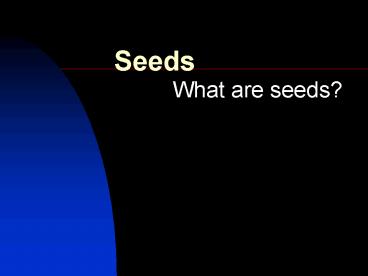Seeds - PowerPoint PPT Presentation
Seeds
3. Radicle (root) emerges. Germination. 4. Plumule or embryonic shoot emerges ... Radicle- primary root, supports seedling. Dicot Seeds. 1. Seed Coat-protection ... – PowerPoint PPT presentation
Title: Seeds
1
Seeds
- What are seeds?
2
Basic Parts of Seeds
- 1. Embryo
- 2. Food Supply
- 3. Ovary wall or seed coat
3
Germination
- Needed for Germ
- 1. Temperature
- 2. Moisture
- 3. Air
- 4. Light or absence of it
4
Germination
- Process
- 1. Seed absorbs water
- 2. Seeds proteins activated
- 3. Radicle (root) emerges
5
Germination
- 4. Plumule or embryonic shoot emerges
- 5. Leaves form and food production begins
6
Monocot Seeds
- 1. Seed coat-protection
- 2. Endosperm- a source of energy
- 3. Embryo-miniature plant that has
7
Monocot Seeds
- 3.Embryo
- Epicotyle-shoot above cotyledon
- Hypocotyl-part of stem below the cotyledon
- Radicle- primary root, supports seedling
8
Dicot Seeds
- 1. Seed Coat-protection
- 2. Embryo miniature plant
9
Dicot Seeds
- 2. Embryo-
- 2 cotyledons-seed leaves
- Epicotyl-true leaves
- Hypocotyl-first stem, pulls seed upward
- Radicle-forms roots
10
Monocot Germination
- 1. Seed swells
- 2. Radicle grows down
- 3. First internode and epicotyl grows upward
11
Monocot Germination
- 4. New leaves form and food production starts
- 5. New root system develops
- 6. Temporary root system ceases to function and
dies
12
Dicot Germination
- 1. Seed swells
- 2. Radicle grows down
- 3. Hypocotyl forms arch that breaks soil surface
13
Dicot Germination
- 4. Hypocotyl reaches light and straightens up
- 5. Cotyledons turn green and make food
- 6. As new leaves develop, cotyledons dry up and
fall off
PowerShow.com is a leading presentation sharing website. It has millions of presentations already uploaded and available with 1,000s more being uploaded by its users every day. Whatever your area of interest, here you’ll be able to find and view presentations you’ll love and possibly download. And, best of all, it is completely free and easy to use.
You might even have a presentation you’d like to share with others. If so, just upload it to PowerShow.com. We’ll convert it to an HTML5 slideshow that includes all the media types you’ve already added: audio, video, music, pictures, animations and transition effects. Then you can share it with your target audience as well as PowerShow.com’s millions of monthly visitors. And, again, it’s all free.
About the Developers
PowerShow.com is brought to you by CrystalGraphics, the award-winning developer and market-leading publisher of rich-media enhancement products for presentations. Our product offerings include millions of PowerPoint templates, diagrams, animated 3D characters and more.































